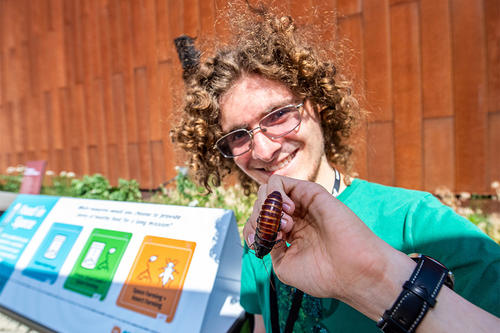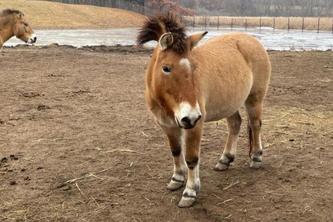
What’s an aerospace engineering major doing raising cockroaches—and getting credit for it? Thinking ahead to voyages to the moon and Mars, that’s what.
“I’ve always known that using insects as a food source is something that could be done for space,” says Andrew Surine, a College of Science and Engineering (CSE) student who minors in astrophysics and entomology, the study of insects.
Crickets, mealworms (beetle larvae), and cockroaches make good sources of nutrition. (And as we all know, cockroaches are easy to raise.) Surine, with other students, is designing a mechanical, self-automated box to farm cockroaches on a spaceship, where strict limits on resources, size, and weight apply. Because they meet these standards, NASA is interested in exploring their use as food for astronauts, either raw or ground up into a meal.
“We’re designing and building something that’s completely new. And that’s pretty exciting,” Surine says.
Making meat meatless
During the COVID-19 pandemic, meat shortages and the uptick in meat substitutes caught the attention of Maddi Johnson.
“It was really cool that we saw such a huge rise in plant-based products during the pandemic,” says Johnson, a CSE student majoring in bioproducts and biosystems engineering. “And the technology behind it is also something I’m really interested in, like fermentation.”
Companies in the United States and abroad are working on plant-based meat alternatives, both to reach vegetarians and vegans and to cut the substantial greenhouse gas emissions from animal agriculture.
Working in Professor Pam Ismail’s lab—part of the College of Food, Agricultural and Natural Resource Sciences’ Plant Protein Innovation Center—Johnson helps with optimizing pennycress and alfalfa protein extraction. She hopes the experience will help her land a research or engineering position at a plant-based food company after graduation.
Companies “need to figure out how to mass produce it,” Johnson says. “I think that’s where engineers can come in and help out.”
Chemical sleuths, human and digital
Sometimes, researchers study chemical reactions whose precise mechanisms elude them—mechanisms that may be crucial to understand for scientific or commercial reasons. To pin down such details they need people like Brianna Collins.
A chemistry graduate student in CSE, Collins simulates chemical reactions in a computer. Her simulations draw on quantum mechanics, the branch of physics that describes the often bizarre behavior of subatomic particles like electrons and photons.
No great fan of lab work, Collins relishes getting computers to dissect chemical reactions right down to the atomic scale.
“We’ve had situations where an experimental group didn’t fully know how to explain some of their results,” she says. “So they asked us, ‘Hey, can you play detective and try to model this [to figure out] why this certain phenomenon is happening?’”
Her work has applications in, among other areas, electrochemistry, in which electrons drive chemical reactions. Electrochemistry could potentially replace processes that run on fossil fuel energy or that are, like the refining of raw materials, polluting and labor intensive.





